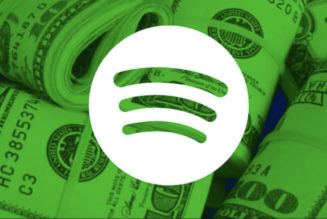
For people in the business of buying and selling music rights, the most striking aspects of the new Goldman Sachs “Music in the Air” report are the revisions — some downward — to the forecasts for revenue at the end of the decade.
Not only is the report a closely watched report card for many segments of the global music business — streaming, recorded music, publishing, concerts and merchandise — “Music in the Air” is widely cited for its long-term forecasts. The first “Music in the Air” report came out in 2016, a time when global recorded music revenue had just started to rebound after a decade and a half of losses. Compared to today, far less money was being invested in music in 2016. Spotify, Universal Music Group, Hipgnosis Songs Royalty Fund, Reservoir Media, Believe and many other music companies weren’t yet public companies. Goldman Sachs analysts saw the upcoming streaming boom and predicted that the global music industry would double in size by 2030.
Forecasting what happens in 2030 is largely an academic exercise that’s outside the day-to-day concerns of people toiling in the music industry’s trenches. But long-term outlooks are important to the booming catalog acquisition business. How much a buyer is willing to pay for music assets depends on, among other things, what those assets are expected to generate over their useful lifetimes.
In recent years, fast-paced growth in streaming revenue — and, importantly, widespread belief that growth will continue for the foreseeable future — has made music an attractive asset class. Investors have raised billions of dollars to splurge on music publishing and master recording rights, producer incomes and performance and neighboring rights royalties. Sellers have benefitted greatly from the spending spree’s impact on prices.
Goldman Sachs’ forecast for 2030 recorded music dropped from $53.2 billion to $50.1 billion. Some of that decrease can be attributed to a $1.7 billion downward revision of 2022 revenue from $27.9 billion to $26.2 billion — a 6% decline. Changes in foreign exchange rates that strengthened the dollar against other currencies were also a factor. At constant currency, recorded music revenue growth in 2022 exceeded Goldman Sachs’ expectations by 1.2 percentage points. With a lower starting point, the lower 2030 forecast means the compound annual growth rate drops only 0.1 percentage points, from 8.4% to 8.3%. A small decrease, but a decrease, nonetheless.
Music publishing, in contrast, now carries higher expectations through the end of the decade. Goldman Sachs analysts increased their forecast for music publishing in 2030 by 27%, from $11.6 billion to $14.7 billion. The publishing business benefits from a revenue mix that includes performance and synch royalties and is less reliant on streaming than recorded music. What’s more, the leading publishers, Goldman Sachs believes, are less exposed to the forces that are allowing independent artists and labels to take market share from the major labels.
The most notable change in “Music in the Air” came from the factor described in the 2016 report as “driving a new era of growth” for the global industry: streaming. The 2030 forecast for gross streaming revenue — the money collected by streaming platforms — decreased by 10%, from $89.3 billion to $80.3 billion. Gross revenue from paid streaming services dropped only 7%, from $55.6 billion to $51.7 billion. Advertising-funded streaming took the bigger hit by falling 15%, from $33.7 billion to $28.6 billion. Goldman Sachs also lowered its forecast for trade revenue from streaming services — paid out to labels, publishers and PROs — by 10%.
The estimates for streaming growth rates actually improved slightly, however, except for ad-supported streaming. This may seem counterintuitive at first: the streaming revenue forecasts declined and the growth rates increased. Recall that some 2022 revenue figures came in lower than Goldman Sachs’ forecasts. Changing 2022 numbers creates a lower base on which revenue will grow through the rest of the decade. So even though 2030 forecasts are lower than previously expected, the annual growth rate improved a few tenths of a percentage point.
The report includes three noticeable warning signs regarding the subscription market’s lowered forecasts. Goldman Sachs analysts lowered the 2030 forecast for global streaming subscribers from 1.26 billion to 1.2 billion, a 5% decrease. Compounding the drop in subscribers is an expected 5% decline in average revenue per user.
What’s more remarkable is where those subscribers are expected to come from, not that the forecasted number of subscribers dipped slightly. Both developed and emerging markets are expected to grow considerably through the end of the decade. In total, the number of subscribers is expected to climb from 589 million at the end of 2022 to 1.2 billion by 2030. But the 2030 forecast for subscribers from developed markets grew 15% from 502 million to 579 million, while the forecast for emerging markets fell 18% from 758 million to 621 million.
Although the analysts expect developed markets to have a 3% headline pricing growth in 2023, those pricing gains will be diluted by emerging market pricing and bundles that lure new subscribers but produce a lower average revenue per user.
The live music business fares well in the new report. Goldman Sachs’ 2030 forecast for live music revenue grew 3%, from $38.3 billion to $39.5 billion. Moreover, Goldman Sachs left its 2022 figure for live revenue unchanged at $26.5 billion. The result is a slight uptick in live music’s compound annual growth rate through 2030: from 4% to 5%.
There’s room for improvement in the coming years, especially for record labels. Goldman Sachs’ forecasts omitted any effects from three factors that could remedy the lowered forecasts: upcoming changes to streaming payouts, potential elimination of fraudulent streams and potential monetization of “superfans.”
For starters, the analysts believe music is under-monetized. Netflix generates four times as much revenue per hour streamed as Spotify, they note, and revenue per audio stream has declined 20% in the last five years. Also, streaming could get more money from listeners if more price increases follow the recent price hikes of Apple Music and Amazon Music. And the way royalties are calculated “needs to adapt” to the threat of fraudulent streams and a system for paying royalties that treats three-minute pop songs and 10 minutes of rainforest sounds equally. All would boost royalties to labels and publishers and, in turn, give investors and artists the healthy catalog market they desire.









